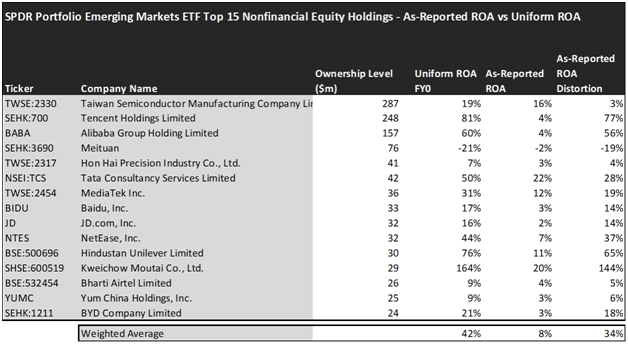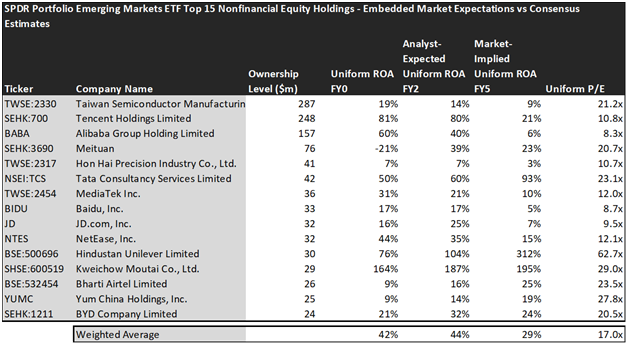Emerging markets are seen as risky due to their unstable political and economic conditions, causing investors to overlook their potential for high returns and diversification benefits. That said, SPDR Portfolio Emerging Markets ETF (ARCA: SPEM) is a popular option for those seeking opportunities beyond domestic markets. In today’s FA Alpha Daily, we’ll analyze SPEM using uniform accounting to assess whether the potential returns justify the underlying risks.
FA Alpha Daily:
Friday Portfolio Analysis
Powered by Valens Research
Here at Valens, we think that U.S. stocks provide most of what investors should need for years to come, but there’s nothing inherently wrong with investing in emerging market equities.
It is important to understand, however, that there is a possible political risk involved.
Political instability in these countries can lead to changes in government policies, regulations, and laws that can significantly impact the companies’ business environment and profitability.
For instance, last week, we talked about political risks in China and why Soros Fund Management was probably smart to keep away from Chinese stocks in the last few years.
The Chinese government has shown it’s not afraid to step in when it feels like it needs to, and this intervention was not welcomed nicely by the markets.
These types of events usually lead to a loss of investor confidence, and ultimately they negatively impact stock markets.
However, as a result of these risks, these markets often trade at a discount to major markets like the U.S. This creates opportunities for investors who are willing to take on some additional level of risk in exchange for a higher return potential.
Additionally, emerging markets are an important diversification tool for investors’ portfolios. They can offer exposure to economies and sectors that have different market dynamics.
In light of this, let’s take a look at some of the biggest emerging market companies in the SPDR Portfolio Emerging Markets ETF and see if getting a bit of exposure outside the U.S. is worth it.
Economic productivity is massively misunderstood on Wall Street. This is reflected by the 130+ distortions in the Generally Accepted Accounting Principles (GAAP) that make as-reported results poor representations of real economic productivity.
These distortions include the poor capitalization of R&D, the use of goodwill and intangibles to inflate a company’s asset base, a poor understanding of one-off expense line items, as well as flawed acquisition accounting.
It’s no surprise that once many of these distortions are accounted for, it becomes apparent which companies are in real robust profitability and which may not be as strong of an investment.
See for yourself below.


Looking at as-reported accounting numbers, investors would think that investing in emerging markets and taking on these risks is not rewarding at all.
On an as-reported basis, many of the companies in the fund are poor performers. The average as-reported ROA for the top 15 holdings of the fund is 8%, which is significantly below the U.S. corporate average of 12%.
However, once we make Uniform Accounting adjustments to accurately calculate the earning power, we can see that the average return in SPDR Portfolio Emerging Markets ETF’s top 15 holdings is actually 42%.
As the distortions from as-reported accounting are removed, we can see that Kweichow Moutai (SHSE:600519) isn’t a 20% return business. Its Uniform ROA is 164%.
Meanwhile, Alibaba (BABA) looks almost like an unprofitable company with below the cost of capital returns of around 4%. In fact, this massive e-commerce company actually powers a 60% Uniform ROA.
That being said, to find companies that can deliver alpha beyond the market, just finding companies where as-reported metrics misrepresent a company’s real profitability is insufficient.
To really generate alpha, any investor also needs to identify where the market is significantly undervaluing the company’s potential.
These dislocations demonstrate that most of these firms are in a different financial position than GAAP may make their books appear. However, there is another crucial step in the search for alpha. Investors need to also find companies that are performing better than their valuations imply.
Valens has built a systematic process called Embedded Expectations Analysis to help investors get a sense of the future performance already baked into a company’s current stock price. Take a look:


This chart shows four interesting data points:
- The average Uniform ROA among Soros Fund Management’s top 15 holdings is actually 42% which is much better than the corporate average in the United States.
- The analyst-expected Uniform ROA represents what ROA is forecasted to do over the next two years. To get the ROA value, we take consensus Wall Street estimates and convert them to the Uniform Accounting framework.
- The market-implied Uniform ROA is what the market thinks Uniform ROA is going to be in the three years following the analyst expectations, which for most companies here are 2023, 2024, and 2025. Here, we show the sort of economic productivity a company needs to achieve to justify its current stock price.
- The Uniform P/E is our measure of how expensive a company is relative to its Uniform earnings. For reference, the average Uniform P/E across the investing universe is roughly 20x.
Embedded Expectations Analysis of SPDR Portfolio Emerging Markets ETF paints a clear picture. Over the next few years, Wall Street analysts expect the companies in the fund to slightly improve in profitability. However, the market thinks the opposite and is pricing in declined profitability for the companies in the portfolio.
Analysts forecast the portfolio holdings on average to see Uniform ROA increase to 44% over the next two years. At current valuations, the market’s expectations are way lower than analysts, and it expects a 29% Uniform ROA for the companies in the portfolio.
For instance, JD.com (JD) returned 16% this year. Analysts think its returns will improve to 25%. And at a 9.5x Uniform P/E, the market expects profitability to fall significantly and is pricing Uniform ROA to be around 7%.
Similarly, Baidu’s (BIDU) Uniform ROA is 17%. Analysts expect its returns will remain roughly the same, at around 17%, but the market is highly pessimistic and pricing its returns to be around 5%.
Overall, the ETF provides an important opportunity for investors looking to diversify their portfolio with emerging markets.
There are names that can provide high-quality and high-growth in exchange for the risks taken, but investors should be careful about following the macroeconomic environment closely while investing in these markets.
Additionally, investors should analyze the current valuations and shouldn’t jump on these companies just because they seem cheaper than peers in developed markets.
On the other hand, low expectations of the market for these names provide a significant upside for investors who carefully want to take the risk and be exposed to different markets around the world.
This just goes to show the importance of valuation in the investing process. Finding a company with strong profitability and growth is only half of the process. The other, just as important part, is attaching reasonable valuations to the companies and understanding which have the upside that has not been fully priced into their current prices.
To see a list of companies that have great performance and stability also at attractive valuations, the Valens Conviction Long Idea List is the place to look. The conviction list is powered by the Valens database, which offers access to full Uniform Accounting metrics for thousands of companies.
Click here to get access.
Read on to see a detailed tearsheet of one of SPDR Portfolio Emerging Markets ETF’s largest holdings.
SUMMARY and Taiwan Semiconductor Manufacturing Company Limited Tearsheet
As one of SPDR Portfolio Emerging Markets ETF’s largest individual stock holdings, we’re highlighting Taiwan Semiconductor Manufacturing Company Limited (2330:TAI) tearsheet today.
As the Uniform Accounting tearsheet for Taiwan Semiconductor Manufacturing Company Limited highlights, its Uniform P/E trades at 21.2x, which is above the global corporate average of 18.4x and around its historical average of 20.7x.
High P/Es require high EPS growth to sustain them. In the case of Taiwan Semiconductor Manufacturing Company Limited, the company has recently shown 60% Uniform EPS growth.
Wall Street analysts provide stock and valuation recommendations that, in general, provide very poor guidance or insight. However, Wall Street analysts’ near-term earnings forecasts tend to have relevant information.
We take Wall Street forecasts for GAAP earnings and convert them to Uniform earnings forecasts. When we do this, Taiwan Semiconductor Manufacturing Company Limited’s Wall Street analyst-driven forecast is for EPS to shrink by 29% in 2023 and to grow by 29% in 2024.
Furthermore, the company’s return on assets was 19% in 2022, which is 3x of the long-run corporate averages. Also, cash flows and cash on hand consistently exceed its total obligations—including debt maturities and CAPEX maintenance. Moreover, its intrinsic credit risk is 40bps above the risk-free rate. Together, these signal low dividend risks and low credit risks.
Lastly, Taiwan Semiconductor Manufacturing Company Limited’s Uniform earnings growth is below peer averages and above peer valuations.
Best regards,
Joel Litman & Rob Spivey
Chief Investment Strategist &
Director of Research
at Valens Research
This portfolio analysis highlights the same insights we share with our FA Alpha Members. To find out more, visit our website.
